Douglas Dunn + Dancers’ Antipodes comes to roost in Danspace St. Mark’s.
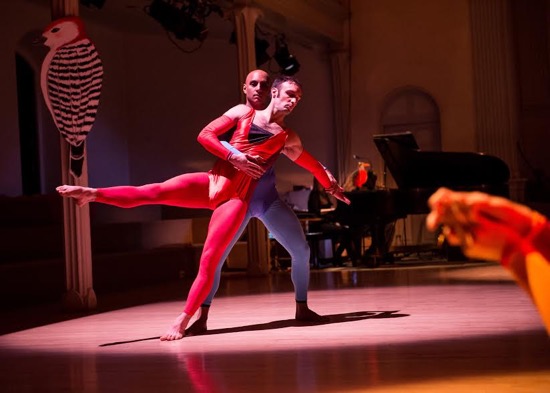
Paul Singh supports Christopher Williams in Douglas Dunn’s Antipodes. Laura Brenneman at the piano, Mimi Gross’s woodpecker on the pillar. Photo: Ian Douglas
If Douglas Dunn could see himself from behind, would his mind flip as well? This is not the kind of question most choreographers ask themselves. He does. Nor might many be tempted to name a dance of theirs Antipodes and then consider the many ways in which that term can be defined—say, as opposites, congenial or in conflict. Also, the Antipodes are islands off the coast of New Zealand. When I travel to Australia by plane, I look at clouds and movies about koalas and try to sleep. I don’t think, as Dunn did on a trip with his company, about the curving path that the plane is taking around the earth and how much shorter the trip would be if we could follow the earth’s axis in a straight line.
Whatever calculations went into determining the paths the dancers in Antipodes take, as well as what compels them into congruence or opposition and what effects the moon has on the earth, these are not factors that Dunn would urge the spectators assembled at St. Marks Church to focus on when viewing this gorgeous, playful, mysterious, deep-rooted work presented by Danspace Project.
Birds flew long before planes did, and a flock of small black facsimiles is suspended overhead. They’re not the only avians. Flat, two to three-foot tall birds by artist Mimi Gross perch around the church. An owl is several times lit by Carol Mullins to cast its shadow on the wall behind it. If I were a giant child, in proportion to these structures, I might consider this place a playground for tiny, brilliantly garbed human creatures. Gross’s costumes relate certain of Dunn’s dancers to these birds— all natives of New England. Jin Ju Song-Begin wears the patterns and colors (red, black, and white) of a certain woodpecker. Emily Pope, like the oriole on display, is mostly garbed in yellow. Christopher Williams, all in red, evokes a male cardinal, and Paul Singh a bluejay. The garb of Jules Bakshi, Alexandra Berger, Jake Szczypek, and Timothy Ward is gaudier than the feathers of the remaining painted birds (sparrow, grosbeak, and robin); only in the southern hemisphere countries might you see plumage this vivid in the wild. At one point, the dancers pick up filmy hooded jackets from the floor that, once donned, hint at wings and bird-shaped heads.
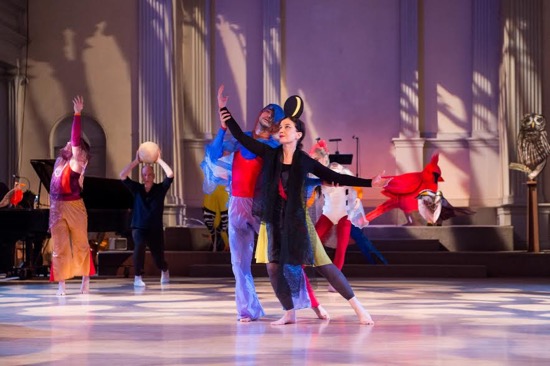
Timothy Ward and Grazia Della-Terza in Antipodes (dress rehearsal). At back (L to R): Jake Szczypek, Douglas Dunn, Jin Ju Song-Begin, cardinal, and owl. Photo: Ian Douglas
The score involves a collaboration between poet-musician-composer Steven Taylor and composer- musician Laura Brenneman (additional music by Shawn O’Sullivan and Katie O’Sullivan). Brenneman sits at the piano, but several times Taylor leaves his electronic controls (but not always his guitar) to come to a microphone to sing or speak. He has said that he considers his antipodal contribution to be the music of different eras; he pairs centuries, for example, by delivering William Blake’s anti-clerical poem “The Garden of Love” in a setting by Allen Ginsburg. And the composers’ dramatic and dynamically variable original score is a long way from a love song Taylor delivers that’s written in the ancient langue d’oc of France, plus another plaint by a wandering medieval scholar and, later still, a Greek drinking song written within the hundred years that separate B.C.’s dwindling dating to A.D.’s upward advance.
Into an atmosphere of shifting climes, as defined by Mullins’s beautiful lighting and punctuated several times by blackouts, two additional characters make three appearances. The program identifies Dunn and his long-time partner, Grazia Della-Terza as the White Dwarf and The Moon respectively. In two of these duets, he wears a different fantastic costume (constructed by Andrew Jordan, based on ideas by Dunn).
Here is one dictionary definition of a white dwarf: “a star, approximately the size of the earth, that has undergone gravitational collapse and is in the final stage of evolution for low-mass stars, beginning hot and white and ending cold and dark.” It would be presumptuous for me to apply that to Douglas Dunn or interpret his appearances in relation to it. The first time, he dances (“waddles” might be a more accurate term), his head is invisible beneath a brown mask and hat, his body confined by a bulky brown suit that emphasizes his joints. He looks as if he’s made of mud. Thus disguised, he rolls along with him a brown ball about 32 inches in diameter, whose crater-pitted surface suggests it is a dead planet. A lattice is projected on the wall at the back of the altar platform, and Della-Terza reaches out to the space around the two of them, a long train of fabric following.
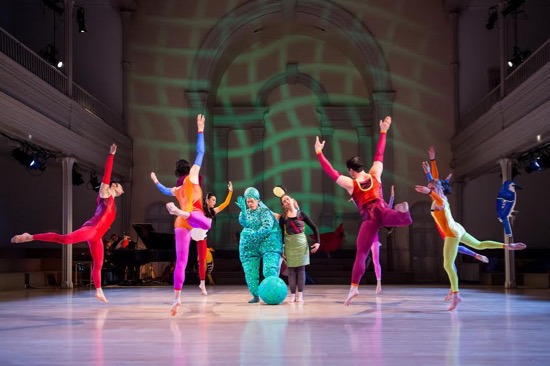
Douglas Dunn’s Antipodes (L to R): Christopher Williams, Jules Bakshi, Jin Ju Song-Begin (partially hidden), Douglas Dunn, Grazia Della-Terza, Jake Szczypek, Emily Pope, blue jay. Photo: Ian Douglas
The second time these two appear, Dunn looks like a walking hedge that’s been clipped into a ball, with a smaller green ball on his head; on closer examination, the fat suit is studded with tiny beads that catch the light. He appears disturbed. This time too he has a matching globe that he gets Della-Terza to hold for him, then takes back; the two are often spinning, as celestial orbs tend to do, as well as looking up in a questioning way like the rest of us.
On the pair’s third appearance, he’s wearing black tights, a black t-shirt, and white sneakers. And now he can dance in his own, charmed, lost-looking way, coping with a smooth pale ball and swift-footed in a universe that he is, perhaps, attempting to understand. Della-Terza’s headdress has a crescent moon on it, rather than the three-quarter moon in an earlier appearance. Again, he gives the ball to her; again he takes it back. But this time, she frolics around him, charming in her flirtatious gaiety. Opposites attract and may involve give-and-take. . . is that what these encounters are, in part, saying?
Embedded in Antipodes, these three scenes must, various ways, be affecting what the other splendid performers are doing. Dunn makes fine dancing for them—dancing that contrasts in unusual, yet seemingly organic ways, large, whole-body moves with small isolations of arms, head, or feet; precise gestures with wilder ones; rapid bursts of motion with slower, smoother ones. In other words, the choreography is textured, like a good conversation. The dancers perform intently, without guile or display or attempts to woo the spectator.
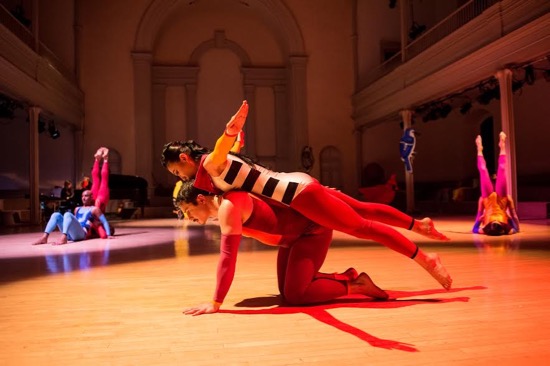
Douglas Dunn’s Antipodes. (L to R): Paul Singh (in blue) and Christopher Williams, Jake Szczypek and Jin Ju Song-Begin, Jules Bakshi and Alexandra Berger. Photo: Ian Douglas
In the beginning, they do evoke birds—perched on one leg, gazing about, shaking themselves;—while we hear long notes that stop, then start up again, and the emergence of ringing sounds. There’s a section in which, to the music of piano and cello, they explore their possible relationships, one circling another slowly and almost sensually or the two pairing up in combats—Pope and Ward, Williams and Singh, Bakshi and Berger, Song-Begin and Szczypek. But combats aren’t the whole story; pretty soon, the partnering begins to seem like dialogues, even when one flips the other over in a handstand. Their moves are strenuous and complex; when the lights dim, and performers re-position the birds, there’s a burst of applause.
Some of the activities are formal (Bakshi and Pope even acquire, briefly, little skirts). Starting in the space’s four corners, each performer makes a springy foray into the center while others freeze. Now they’re each holding up a curved arm and bending sideways, somewhat like a Spanish dancers, now they’re jumping, bent-legged in the air and landing with their legs wide apart. From doing different things at the same time or the same things at different times, they suddenly all run into a neatly-spaced line and spend time wheeling their arms vigorously in perfect synchrony. They link arms and surround Dunn and Della-Terza when he’s in his green outfit and fall to the floor when the two of them deal with the globe; then they sit and squirm or rise, wriggling. They may keep up with perky percussion or decide to slide smoothly among its beats. To the sound of a guitar, they pair up and embark on what has the air of a baroque court dance, but isn’t.
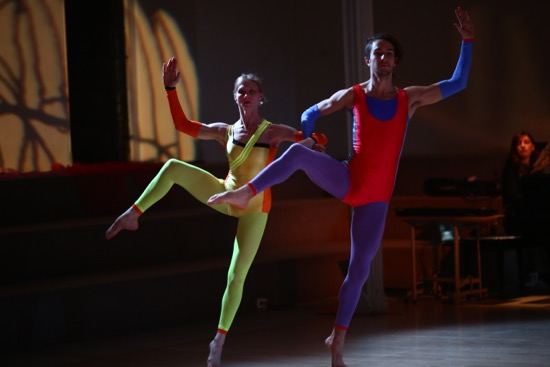
Emily Pope and Timothy Ward in Douglas Dunn’s Antipodes. Photo © Paula Court
I say all this, in an attempt to convey how imaginative, surprising, and yet how orderly the choreography is. At some point, as the eight highly individual dancers performed, I thought of Chaucer’s “Parlement of Foules,” when all the birds of the world assemble in a garden governed by the goddess Nature to choose the mates she has selected for them. Still, after Dunn’s marvelous performance in the sequence involving the white ball, turbulence develops, along with occasional discords in the music, and everyone spins. As I recall, Della-Terza, touching them, sets them in motion. I cannot speak as to the ending. I remember a spoken dialogue I cannot hear, Ward positioning The Moon, The White Dwarf sneaking away, shaking his globe. Others beginning to. . . .And then, surprise! Mullins turns off the lights, and it’s over. (Just so swiftly can our earth end?)
The opening-night spectators are delighted, amused, and impressed by Antipodes; maybe some are wondering, like me, whether they didn’t probe deeply enough into Dunn’s imaginative vision. Is this piece indeed a wise, witty, and benign tale about love? About opposites reconciling, despite their differences? Or is Dunn also telling of nature unsettled and a planet rolled and tossed around by forces it cannot control?

You invite us to see things
that are just beyond our grasp —
imagination becomes elastic
and we feel smarter for it.
I longed to see this dance.